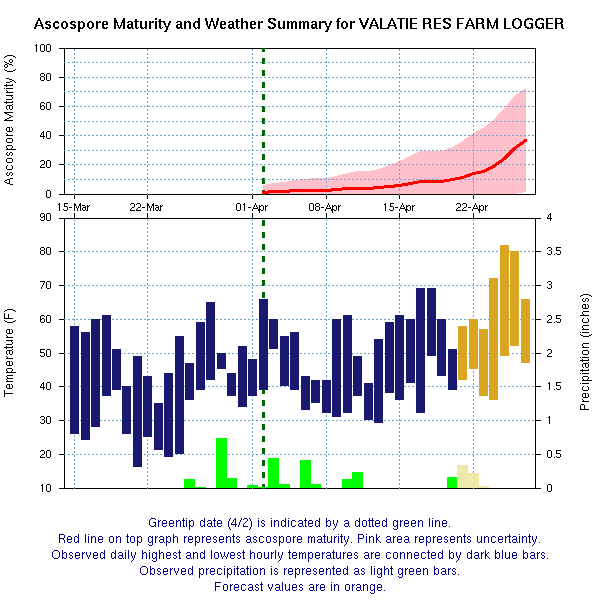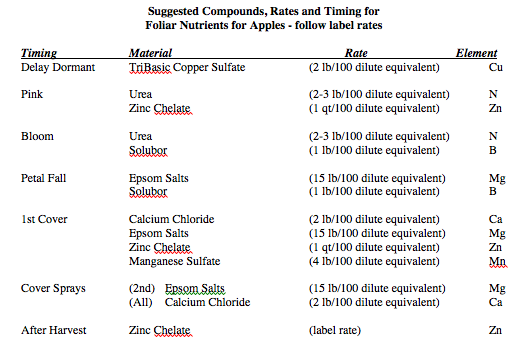Current (April 20) degree day (DD) Accumulations
Location: UMass Cold Spring Orchard (CSO), Belchertown, MA
- Base 43: 170
- Base 50: 65
Significant orchard events based on degree days (Base 43):
- pear psylla 1st egg hatch: 174–328
- spotted tentiform leafminer 1st oviposition: 143–273
- rosy apple aphid nymphs present: 134–244
- obliquebanded leafroller larvae active: 158–314
Current bud stages
| Location |
McIntosh
apple -- half-inch green |
Bartlett
pear -- early bud burst |
PF-14 Jersey
peach -- swollen bud++ |
Cavalier
sweet cherry -- swollen bud+ |
|---|---|---|---|---|
|
Belchertown |
 |
 |
 |
 |
The way I see it
If you believe the forecast, it's going to warm up – significantly – this weekend. So, better be thinking about these management activities:
- If you did not have a good scab protectant on before today's wet weather, you better go out and apply fungicide with some kickback -- Flint, Sovran, Inspire MP, etc. After this, it looks relatively dry, but soon we will be entering the accelerated ascospore maturity phase, so you all know the routine.
- We will be into pink bud or even approaching bloom in peaches early next week. Dan Cooley says it is important to control brown rot during bloom if weather conditions are favorable, i.e. warm and wet. Bravo, Captan, or sulfur are the best options during bloom. Save the SI fungicides for the pre-harvest, fruit infections. There are many fungicide options for controlling brown rot -- please consult the 2009 New England Tree Fruit Management Guide. If you don't have one, buy one now!
- Oil should still be going on at reduced rates (1 to 1.5%) for mites in apples. Also oil (1%) for pear psylla to deter egg laying can still be applied. There are many other pear psylla control options as we reach the pre- and post-bloom periods, including pyrethroids, Actara, Assail, Leverage, Centaur, and Movento. (Among others probably.)
- Speaking of pears, don't forget about Fabraea leaf spot. Like apple scab, it can get ugly if not controlled during the primary infection period. EBDC fungicides applied on protective schedule are the most common and effective control.
- Adult leafminers are probably flying, but we don't generally treat for this generation.
- An apple pink spray would target plant bug (if necessary), obliquebanded leafroller, and rosy apple aphid. Pyrethroids would tarket all of the above, and add leafminer and early plum curculio, but as we know, their use is discouraged because of the negative impact on beneficial insects. Assail or Calypso would be better choices in terms of safety to beneficial insects during this period, and will have lesser, but moderate, activity on all of the above pests.
J. Clements
Lorsban update
The April 20, 2009 edition of Scaffolds Fruit Journal has a 3 page chart outlining the options for Lorsban use in 2009. Here is my executive summary of most interest to you.
- Lorsban 4E and Advanced (Dow) are restricted use pesticides (RUP's) and can be used on pome and stone fruit. Lorsban 50W is no longer available. Lorsban 75WG (Gowan) is also available for use on pome and stone fruit.
- On apple, Lorsban 4E is limited to ONE application TOTAL per year. It can be used as a dormant/delayed-dormant (pre-bloom) canopy spray to control tarnished plant bug, OBLR, rosy apple aphid, scale. OR it can be used a post-bloom trunk spray. The important point is you can only spray it once per year. So, if you use a canopy spray you canNOT use it for a post-bloom trunk spray to control borer.
- Lorsban Advanced on apple can ONLY be used as a dormant/delayed-dormant canopy or trunk spray. No post-bloom trunk application is allowed. ONE total application per year by petal fall.
- Lorsban 75WG can be used twice on apples, either as two foliar sprays (dormant/delayed dormant and/or through petal fall), or as one foliar spray and one post-bloom trunk spray. Thus, it may be used TWO times, once per year for two of the above-described scenarios.
- For peaches, it appears all three Lorsban products can be used ONE time per year only. Either as dormant/delayed dormant application, or postbloom trunk spray only.
You should always read the label to be sure your application is compliant.
J. Clements
Trac Software for 2009 available
For the last couple years, the Cornell/NYS IPM Program has made Trac Software freely available. From their website, Trac Software "Keep records up-to-date, generate reports, analyze pest management strategies and improve IPM practice with Trac software. Instead of filling out several forms for different reports, enter the record once in Trac software. Trac creates reports for you, plus an EPA Worker Protection Standard (WPS) Central Posting form." We have used TracApple, TracStoneFruit, and TracCherry at the UMass Orchard for several years now, and once you get past the initial set-up, find it to be very useful. You can download Trac Software here, and if you have any questions, I would be glad to help you out.
J. Clements
NEWA Apple Insect and Disease Models
Just a heads up on looking towards the not-too-distant future, which is now apparently here. The NYS IPM's Network for Environmental and Weather Applications (NEWA) has new "NEWA Apple Insect Models" and "NEWA Apple Disease Models" homepages. I am not going into the details of exactly how to use them, but spend a little time at home in the evening looking at them. In a nutshell, you choose a location (none in Massachusttes, yet), choose a pest of interest (specific insect or disease), hit calculate, and receive a page back with current conditions and summary of the pest status at the location you selected. Look around a bit and I think you will see a pretty robust description of the current pest status. (See the graphic below for an example, generated using the Valatie, NY station on 04/21/09.) I suspect coming soon, in addition to the pest status, will be more specific management recommendations, including chemical controls.
J. Clements

Good Agricultural Practices (GAPs) Food Safety
Wednesday May 6, 2009 1:00-5:30 PM, UMass South Deerfield Research Farm
Foodborne outbreaks linked to fresh produce have increased in recent years. To address this issue, UMass Extension, the UMass Department of Nutrition and the MA Department of Agricultural Resources have teamed up to implement a USDA Good Agricultural Practices (GAP) Training Program for growers and other fresh produce handlers. This event will be held Wednesday, May 6 from 1-5:30 PM at the UMass South Deerfield Research Farm, River Road, South Deerfield. Attendees will learn about bacteria associated with fresh produce, strategies for controlling food safety hazards in all phases of production and USDA Third-Party GAP Audits. Participants will receive a GAP manual, a certificate of participation, and one pesticide credit is offered. Presenters include: Rich Bonanno, Ph.D., UMass Extension Educator 978-361-5650, rbonanno@umext.umass.edu; David Nyachuba, Ph.D., Assistant Professor, UMass Department of Nutrition 413-545-0552 dgn@nutrition.umass.edu; Scott Soares, Commissioner, MA Department of Agricultural Resources and Mike Botelho, MA Department of Agricultural Resources.
Preregistration is required. Registration deadline: April 27, 2009 To register send $50.00 payable to the University of Massachusetts to: Shirley A. Mietlicki-Floyd, UMass Department of Public Health, 205 Arnold House, 715 North Pleasant Street, Amherst MA 01003-9304
Guest article
APPLE FOLIAR NUTRIENT SUGGESTIONS FOR 2009 (Win Cowgill, County Agricultural Agent, NJAES, and Jeremy Compton, Peaceful Valley Orchards, Pittstown, NJ)
reprinted from Rutgers NJAES, Plant & Pest Advisory, Fruit Edition, April 7, 2009
The addition of foliar nutrients has become standard practice for most progressive apple growers to help set fruit and prevent certain physiological disorders. Research by Dr. Ed Stover, formally of the Cornell Hudson Valley Lab, conducted two years of research while he was there on Nitrogen, Boron and Zinc as pre-bloom sprays on apple. He concluded pre-bloom nutrient treatments enhance cropping by increasing retention of flower buds that would otherwise abscise during early bud development. He indicated "the most obvious use of these treatments (N, B, Z) would be on apple blocks where cropping is expected to be light. There is potential to increase both yield and fruit size as along as aggressive thinning practices are followed."
Urea (N) is beneficial on apples for helping to improve fruit set and increase size on apple cultivars that are low in nitrogen as indicated by leaf tissue analysis. Use 2-3 pounds of urea (feed grade, as it dissilves much easier) per 100 gallons of water at pink bud, full bloom, and/or at petal fall to improve fruit set and tree vigor. Use 5 pounds per 100 gallons in cover sprays after petal fall only on nitrogen-deficient trees. Foliar nitrogen is not a replacement for ground applied nitrogen as it does not translocate down into the wood, rather its an aid to fruit set and fruit sizing.
Boron (B) Solubor sprays of 1 pound in 100 gallons of water applied at full bloom and at 1 week after full bloom may reduce cork in apple flesh if boron is deficient. Boron aids calcium movement into fruit. Adequate boron is essential; excessive boron hastens apple maturity and increases fruit drop. Both soil and leaf analyses are essential in determining the need for boron. Apply no more than two sprays per season.
Note: Boron may be added to pesticide sprays. Do not premix Solubor with calcium chloride. Do not apply boron with oil or apply boron when trees are wet with oil as an increased uptake of boron may result causing boron toxicity.
Low levels of Zinc (Z) are know to cause small fruit size especially in Red Delicious, even when no other symptoms of zinc deficiency are evident. Most of our New Jersey soils and orchards are deficient in Zinc.
Tight Cluster to Pink —If Zinc level is low (as indicated by leaf tissue sample) apply zinc chelate (EDTA) at 1 qt liquid formulation per 100 gallons dilute equivalent at tight cluster to pink. Caution: some Zinc products are labeled for repeat applications 2-3 weeks after petal fall and again 4-5 weeks later. Some varieties may be sensitive to Zinc with regard to fruit finish. A better time might be post-harvest applications to increase zinc levels.
Foliar calcium (Ca) applications are the quickest and most effective short-term corrective treatment for control of bitter pit and cork spot in apple. Spray trees with a solution of either calcium chloride or calcium nitrate. Use 2 pounds of calcium chloride or 4.25 pounds of calcium nitrate per 100 gallons of water plus a wetting agent. Calcium nitrate should not be used on trees that contain high to excessive amounts of nitrogen in the leaf tissue as measured by leaf analysis or that are making excessive shoot growth. Make applications at 2-week intervals with the last spray 2 weeks before harvest. These calcium sprays can reduce bitter pit in apples by 50 to 90 percent.
To control cork spot in apple flesh spray trees with 1.5 pounds of calcium chloride or 3.2 pounds of calcium nitrate per 100 gallons of water with first cover spray and include in each subsequent cover spray until a total of 18 to 24 pounds per acre has been applied. The calcium nitrate sprays will apply 2 to 3 pounds of actual nitrogen (N) per acre and should be used only on trees that do not contain high to excessive nitrogen levels as measured by leaf analysis or reflected in excessive shoot growth.
Note: for calcium-sensitive varieties such as Enterprise, Braeburn, Fuji, York, and Cortland apply: Calcium Chloride (CaCl2): 2-3 lb/100 prior to August 1; 3-5 lb/100 after August 1
Late season calcium sprays are usually more effective against cork than early season sprays
Reduced rates of CaCl2 should be applied if there was no rain between applications, or if it is very hot and humid.
